

Site Search
Search within product
No. 724 Published 2020 (R02) .10
Click here for PDF version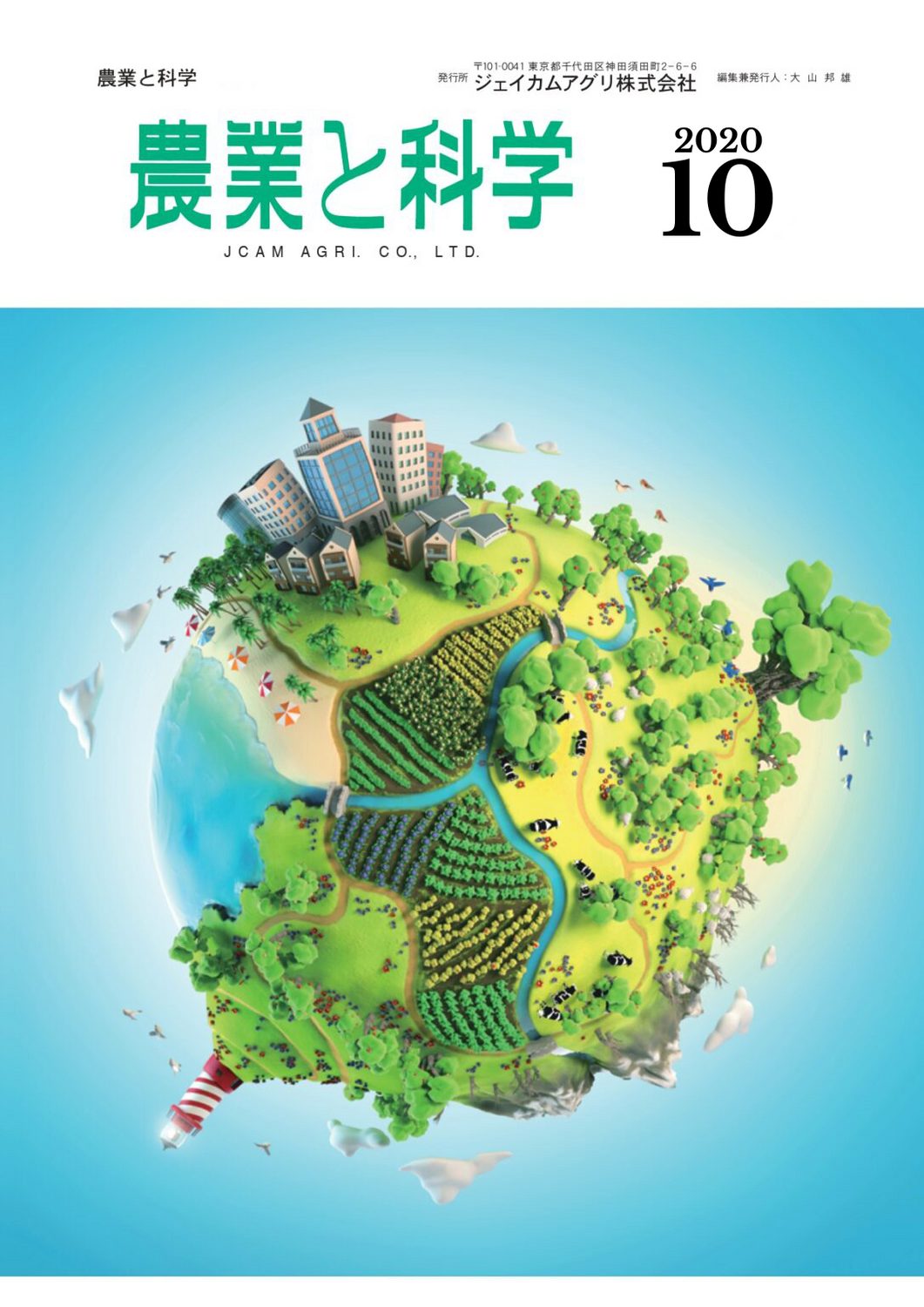
Agriculture and Science 2020/10

本号の内容
§Next generation using ICT technology
主食用米の多収技術構築
Farm Frontier Inc.
山形大学農学部 客員教授
藤井 弘志
§ In continuous-row cultivation of open-air vegetables
セル苗全量基肥を用いた省力技術の試み
Kagoshima Agricultural Development Center
生産環境部 土壌環境研究室
加治屋 五月
The next generation of ICT technology-based
主食用米の多収技術構築
Farm Frontier Inc.
山形大学農学部 客員教授
藤井 弘志
近年,稲作を取り巻く環境は大きく変化しており,水稲の収量・品質の不安定化,年次や圃場毎のバラツキの拡大が生じています。変化の要素として,気候変動,生産体制の変化,稲作技術の変化などがあげられます。気候変動については,地球温暖化に伴う高温,台風,日照不足などの気象災害により,水稲の収量・品質低下を招いています。生産体制の変化については,作業の効率化や省力化を目的とした生産体制(経営規模の拡大,大区画圃場,基肥一発肥料,流し込み肥料等)が増加する傾向にあり,さらに農業従事者の高齢化・減少やベテラン農家の離農など労働力の量的,質的な低下などにより,安定的な生産性の維持が懸念される状況が想定されます。
On the other hand, the introduction of smart agriculture using robot technology and ICT technology, which is expected to promote efficiency, labor saving, and precision in agriculture, is about to begin. Therefore, we present development strategies for the establishment of next-generation high-yield staple rice technology using ICT technology, which can respond to changes in the environment surrounding rice cultivation and adapt to climate change and changes in production systems, from the perspectives of (1) to (4) below.
(1) Technical factors necessary for high rice yield will be introduced based on examples of high-yield rice cultivation.
② 稲作を取り巻く環境(気象,生産体制,稲,技術等)の現状と近未来予測から,生産性の向上に必要な戦略を解説します。 ③ 基肥一発肥料の現状と課題から,今後の改善戦略を解説します。
4) Strategies for building next-generation high-yield staple rice technology using ICT technology will be presented.
1. technological and climatic factors necessary for high rice yield (Figure 1)
Let us briefly summarize the technological elements of the producers who achieved high yields in the "National High Yield Competition" held from 1949 to 1968. The technologies include: (1) a comprehensive soil culture through the implementation of soil preparation (compost, silicic acid, deep tillage, composting, permeability) that corresponds to the conditions of each paddy field; and (2) appropriate fertilizer management techniques (healthy seedling growth, high-yielding varieties, appropriate water management, and high fertilizer application (nitrogen, etc.)). Next, the yield components of high-yielding paddy rice are as follows: (1) securing the number of rice grains per square meter, with 450 to 500 ears per square meter, 80 to 120 grains per ear, and 40,000 to 50,000 grains per square meter, which is a large number of rice grains. The number of rice grains per square meter is 450 to 500, and the number of rice grains per ear is 80 to 120, with 40,000 to 50,000 grains per square meter.
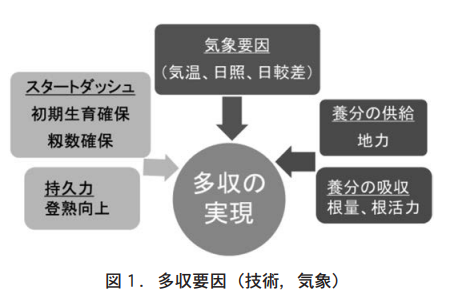
The climatic factors at that time were not as high as today's high temperatures, especially low night temperatures and less respiratory exhaustion, and more sunlight hours than today, which is considered to have increased the amount of photosynthesis by the leaf blades. To achieve high yield, it is important to simultaneously achieve high yield capacity and high crop maturity, and it is considered necessary to simultaneously improve soil fertility such as nitrogen and silicon (on the nutrient supply side) and root volume and root vigor (on the nutrient absorption side) as factors that will make this possible.
2. environment surrounding rice cultivation (weather, production system, rice, etc.)
Strategies necessary to improve productivity based on the current status of (technology, etc.) and near-future projections (Figure 2).
Projections for future rice production indicate that high yields will be difficult to achieve due to further increases in climate change, changes in production systems, and the current deterioration of the environment surrounding rice cultivation.
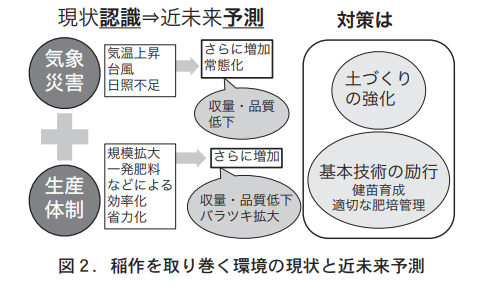
Responding to Climate Change
Due in part to the effects of global warming, weather disasters have been occurring frequently in Japan in recent years. We frequently hear such weather terms as "heat wave," "extreme heat," "bomb cyclone," and "guerrilla downpour. Rainfall is becoming more localized, concentrated, and intense, and the damage to agriculture cannot be overlooked. Agriculture is an industry that is particularly affected by weather, and it is necessary to consider how to respond to climate change from various perspectives.
Global warming does not simply mean a shift toward warmer temperatures. Average weather years will decrease and hotter weather will increase, resulting in the appearance of record-breaking heat. Conversely, cold weather can also occur. The range of variability is not only on an annual basis, but also on a monthly, weekly, or daily basis, as warm weather is followed by a reversal to cold weather.
There is also the problem of lack of sunlight. Plants produce starch from carbon dioxide and water through photosynthesis. In addition, high nighttime temperatures cause the rice plants to respire more actively and consume more starch. As a result, the amount of starch fed to the ears and roots is reduced, causing under-ripening and the generation of immature grains. Figure 3 shows the average temperature and total hours of sunlight in August in Niigata City, Fukui City, and Saga City. This figure also shows that the temperature is higher and the amount of sunlight is lower than in the past. The high temperatures and lack of sunlight are a double whammy, affecting rice growth and possibly reducing yields and quality.
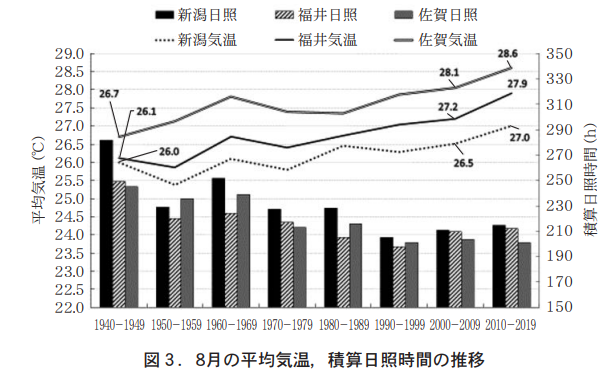
Adaptation to production system (decrease in number of farmers, expansion of scale, one-shot basal fertilizer, etc.)
Table 1 shows the number of farming enterprises by the size of the arable land area under management. The table shows that the number of farm enterprises with large arable land area is rapidly increasing. The trend is toward more efficient and labor-saving production systems (such as increased management scale, large plots, one-shot basal fertilizers, and pour-in fertilizers), which makes it difficult to implement detailed measures to respond to climate change and changes in paddy rice, and makes it easier to lower the yield and quality of paddy rice and increase the variability of the crop. In the near future, more efficient and labor-saving production systems are expected to be adopted.
It will be even more difficult to respond in detail. Further yield and quality losses and increased variability in paddy rice are expected to increase, especially under climate change conditions.
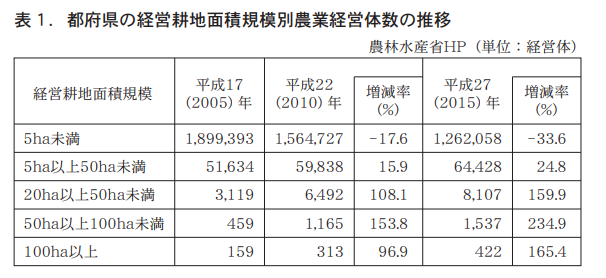
In order to eliminate such concerns, it is necessary to strengthen countermeasures, especially the implementation of basic technologies (healthy seedling cultivation, proper manure management) and soil fertility. In addition, since the labor force is decreasing quantitatively and qualitatively due to the aging and decreasing number of farmers, it is important to establish an efficient production system, including the use of smart agriculture.
3. changes in rice cultivation
As shown in Figure 4, the following details are changing with respect to rice cultivation: (1) rice cultivated, (2) weather, (3) soil preparation, (4) soil fertility, and (5) rice cultivation technology.
First, I will explain the changes in rice cultivated. The "wilting" is a method to determine how many leaf blades are alive on the main stem of the rice plant at maturity, counting from the top.
Yakase rice" refers to rice that is thin in thickness (technically described as having deep longitudinal grooves). (Technically, it is called "thin rice" when the vertical grooves of the rice are deep.) The length and size of rice are determined in this order: length = width = thickness. Factors that increase the amount of "thin rice" include hot summers, reduced nitrogen fertilizer application due to the emphasis on good eating quality, and reduced soil fertility.
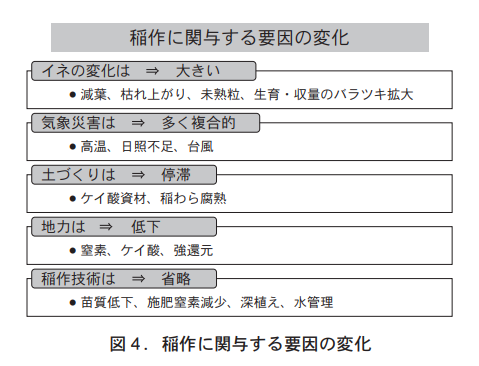
Next, regarding climate change, the frequency of weather-related disasters is increasing, and weather-related disasters are not caused by a single factor, such as high temperatures and typhoons, but by a combination of factors. Soil fertility is necessary when weather-related disasters occur more frequently, but the current situation is that soil fertility is stagnant. In addition, nitrogen and silicic acid soil fertility is also declining. In addition, there is a tendency to omit rice cultivation techniques. There is a saying, "Half the seedling, half the crop," which means that the quality of the seedlings determines half of the rice crop. In reality, however, the quality of seedlings is declining and rice is being planted too deeply, making it vulnerable to climate change.
Furthermore, the current rice cultivation environment is in a state of fourfold suffering due to stagnation in soil preparation and omission of basic technologies (seedling cultivation and proper water management).
The first complaint is the decrease in permeability of paddy fields. Increased tread pressure due to larger agricultural machinery and shallow plowing have reduced the permeability of the soil.
The second complaint is a decrease in root vitality. Insufficient application of silicic acid materials containing alkaline components such as lime causes soil pH to drop. Low soil pH reduces the activity of soil microorganisms from fall to spring and slows the decomposition of raw rice straw, resulting in the formation of strongly reducing soil under waterlogged conditions. The production of organic acids and hydrogen sulfide, which are produced under strongly reducing conditions, is enhanced, damaging the roots, reducing root mass and decreasing root vigor.
The third complaint is the decline in soil nitrogen and fertilizer nitrogen. Due to a decrease in the application of organic matter such as compost, the amount of soil nitrogen in rice paddies is declining. The amount of fertilizer nitrogen is also decreasing due to the trend toward better taste, as people tend to think that rice tastes better when the protein content in the rice is lower. The late-stage wilting of rice due to nitrogen deficiency, combined with recent abnormal weather conditions such as high temperatures, lack of sunlight, and typhoons, is a cause for concern.
The fourth complaint is a decrease in photosynthetic capacity of the leaf blade. The silicon content of the leaf blade also decreases due to a decrease in the amount of silicon supplied to the paddy rice due to a decrease in the amount of silicon applied, resulting in a decrease in photosynthetic capacity.
As a result of these quadruple problems, a vicious cycle of unstable yields and declining quality and eating quality is occurring.
The repetition of these four-fold problems has caused the soil fertility of rice paddies to decline year by year. In order to break this negative spiral, it is important to (1) apply silicic acid materials, (2) suppress strong soil reduction by improving soil permeability and promoting the rotting of rice straw, (3) improve seedling quality and proper water management, and (4) manage nitrogen fertilization appropriately.
Current Status and Issues of One-Shot Basic Fertilizer
The current status of one-shot basal fertilizers also faces various challenges due to climate change, production systems, and deterioration of the rice production environment as indicated above.
Although one-shot basal fertilizers are very good fertilizers, there are certain points to keep in mind when using them. In order to use this fertilizer effectively, you must have the skills to grow healthy seedlings and ensure the levelness of the field. If a one-shot basal fertilizer is used without sufficient seedling development, the poor initial growth will not recover easily due to the lack of fast-acting components, and as a result, the number of stems and ears (rice) will not be sufficient. If the number of hulls is low, there are not enough receptacles for the nitrogen that is leached from the one-shot base fertilizer in the latter half of the growth period, and the protein content in the brown rice increases, leading to poor eating quality. If the fertilizer is too little, there will be insufficient nitrogen from the one-shot basal fertilizer in the second half of the growth period. This leads to a large variation in growth. It is important to use one-shot basal fertilizers in combination with basic technology.
Furthermore, recent climate change has destabilized productivity. As the damage caused by high temperature disorders and lack of sunlight is becoming more common, a detailed response is required for each of these problems.
Large-scale management and large-plot field management will continue to increase in the future. The use of one-shot base fertilizers is expected to increase further. The following strategies for one-shot base fertilizers can be considered in response to the various changes surrounding rice cultivation (climate change, decline in soil fertility, decline in seedling quality).
4. strategies for building next-generation, high-yield technologies for staple rice
Step 1
Perspectives to be considered in relation to the one-shot base fertilizer system and the current rice farming environment (Figure 5)
現状の稲作のマイナス要因であるスタートダッシュと持久力の対策を実施することが重要です。特に,基肥一発肥料の場合は,スタートダッシュや持久力のマイナス要因に対応した対策の実施により,本来の基肥一発肥料の有用性が確保されます。
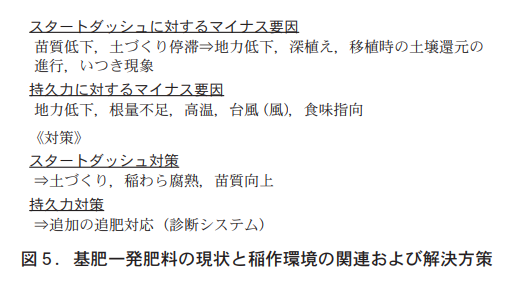
Step 2
Perspectives on reducing variability with a one-shot base fertilizer system.
It is necessary to introduce methods that reduce the variation in growth and yield within and among fields using one-shot basal fertilizer. From the perspective of the rice plant, many people are of the opinion that fertilizer application methods with large fertilizer variability around the rice plant are broadcasters, so it is also necessary to consider fertilizer application methods that reduce the variability. Furthermore, when fertilizer is applied early (around 30 days before transplanting), the ammonia-form nitrogen that is applied is converted to nitrate-form nitrogen, which is lost due to denitrification and runoff after watering, and this prevents the amount of nitrogen expected to be provided to the rice plants at transplanting, which is thought to increase variation. Therefore, it is important to identify problems and implement countermeasures (examining fertilizer application methods and timing) by interviewing those who use one-shot basal fertilizers.
Step 3
Next-generation soil preparation and one-shot basal fertilizer system
The response to production systems such as scale expansion is the introduction of smart agriculture using ICT technology to improve efficiency, labor saving, and precision in operations. We are developing technologies (1) through (3) as a set of technologies, systems, and ICT tools to simultaneously achieve the control of fertilizer loss, sparse planting, soil preparation, field-by-field information use, efficiency, and stable and high yield of paddy rice.
① 土づくりとの連動の考え方:土壌分析・問診票等の情報に基づき,圃場毎のケイ酸資材,稲わら腐熟体系の実践,センシングによる画像データ等からの圃場間および圃場内の土づくり実施場所の選択と集中,情報システムによるケイ酸資材および散布方法の選択システムの構築。
② 施肥連動の考え方:地力(地域変動) +乾土効果(年次変動)等の情報に基づいた側条施肥(速効性N:基肥相当)の窒素量の最適化,地力・品種に基づいた苗箱まかせ(緩効性N:追肥相当)の窒素量の最適化システムの構築。
③ センシングによる「肥料切れ」評価,圃場間の地力評価:ドローンセンシングによる画像診断,移植後の生育スピード,気象条件(気温,日照時間)等の情報による肥料切れ判定システムと施肥対応。圃場間および圃場内のバラツキ把握と可変施肥対応システムの構築。
We are currently conducting basic research and field trials on next-generation high-yield staple rice technology, aiming to establish a soil preparation and one-shot application of basal fertilizer system in conjunction with smart agriculture.
≪Test Cases.
Development of high-yield technology using one-shot basal fertilizer for commercial rice through the use of ICT
Purpose
We evaluated the yield and yield components of varying the amount of fertilizer nitrogen applied in a one-shot basal fertilizer system (all-layer fertilizer application system) to determine the upper limit of the amount of fertilizer applied when aiming for high yield. The relationship between yield and nitrogen absorption is examined from image data obtained by sensing while varying the amount of nitrogen in the base fertilizer, and the information in the image data necessary for high yield is analyzed. The target yield is 720 kg/10a.
2. test method (2019)
(1) Test site: Faculty of Agriculture, Yamagata University (soil fertility condition: low)
(2) Trial product: "Haenuki" (Japanese name: Haenuki)
③ 供試肥料:軽田くん一発708(窒素−リン酸−カリ:27−10−8)(速効性N15%,緩効性NLPコート12%)
Fertilizer application method: All-layer fertilizer application system: Fertilizer application (April 25) ⇒ Tillage ⇒ Watering and plowing ⇒ Transplanting (May 15)
⑤ N施肥量(kg/10a):標準施肥量⇒1.0区を基 準に30%増加させた区(1.3区)と20%減少させた区(0.8区)を設定しました。標準施肥窒素量(10a当たり):全層施肥体系:「はえぬき」 ⇒8kg,ケイ酸施用:転炉スラグ100kg/10a施用
⑥ センシング;7月10日,20日に実施。「はえぬき」の出穂期は8月3日で,7月10日は出穂前24日,20日は出穂前14日でした。
3. test results
① 基肥一発肥料の施肥窒素量が標準施肥量より増加するにつれて,m2当たり籾数が増加し,収量が増加しました。
② 施肥窒素量の増加によって,m2当たり籾数が目標値を3000〜5000粒上回りました。近年の高温障害の助長要因の一つであるm2当たり籾 数の増加も考慮すると,標準の1.3倍の施肥窒素量と光合成を向上させるケイ酸の併用は必要な技術と言えます。
Summary."
センシングによるNDVI値は葉色,m2当たり籾数,窒素吸収量との関係性が認められました。センシングの利用により,圃場間の地力や肥料切れの評価が可能であると考えられます。
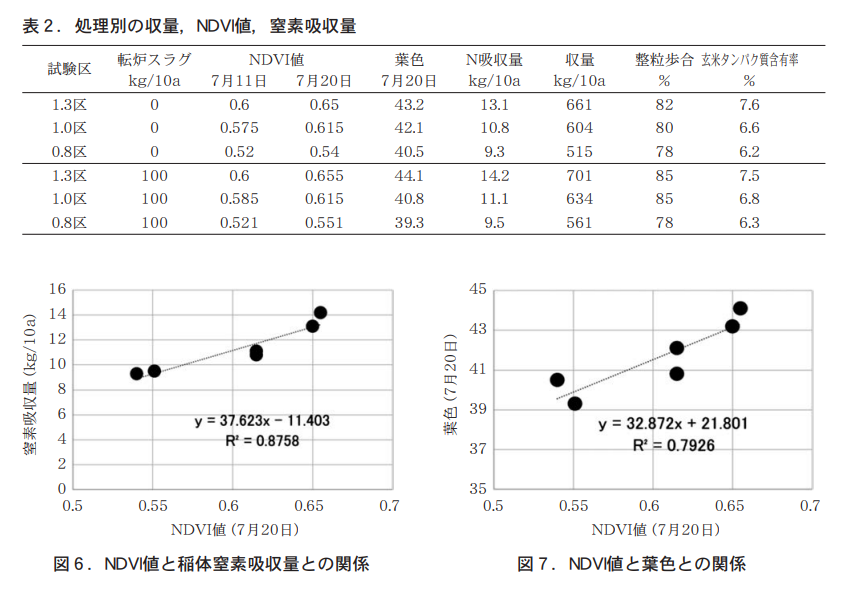
in continuous row cultivation of open-air vegetables.
セル苗全量基肥を用いた省力技術の試み
Kagoshima Agricultural Development Center
生産環境部 土壌環境研究室
加治屋 五月
Introduction
In Kagoshima Prefecture, the production of open-air vegetables for processing and commercial use is flourishing, taking advantage of the mild climate and field canal facilities, and the cabbage crop area in FY 2008 was 1,990 ha, ranking 5th in Japan. While the cabbage acreage is decreasing nationwide, the cabbage acreage in this prefecture is increasing, and the increase in the number of agricultural production corporations of open field vegetables is considered to be the reason for this increase.
In addition, the establishment of fertilizer management technology for labor-saving and low-cost large-scale open-air vegetable production has become an urgent issue (Fig. 1).
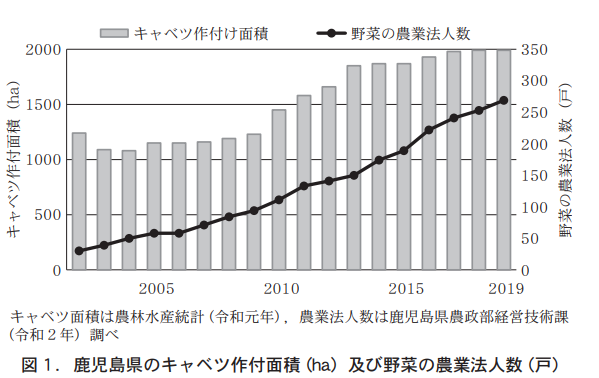
On the other hand, the number of fields with high contents of dietary phosphoric acid and exchangeable potassium in open vegetable production areas in this prefecture has been increasing recently. Therefore, for the purpose of labor-saving and low-cost open field vegetable production, soil diagnosis has been conducted and fertilizer application has been promoted based on fertilizer reduction standards according to the content of available phosphoric acid and exchangeable potassium. In addition, since FY 2015, the agricultural corporation has been working on appropriate fertilizer application based on the diagnosis of ratable nitrogen in addition to fertilizer reduction techniques for phosphate and potassium in the local fields (Photo 1).
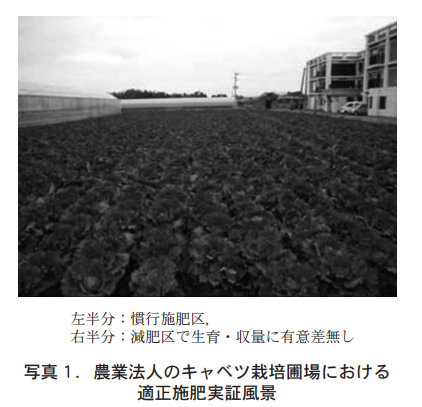
On the other hand, for institutional vegetables such as strawberries and cucumbers, a labor-saving cultivation method called "no-till cultivation" or "continuous-row cultivation" has been developed in which the rows are not broken after harvest and are used as they are in the next crop. The "radish-sweetpotato cultivation system" is also being considered for open-air vegetables.
In this report, we introduce a labor-saving technique for cultivating cabbage in which lettuce is harvested in autumn by mulch cultivation and cabbage seedlings are grown in the same rows with total nitrogen fertilizer applied to the cells (hereinafter referred to as "total basal fertilizer for cellular seedlings").
2. Outline of cultivation method
The tests were conducted in 2015-2018 in a surface humic black box soil plot in the center. The soil chemistry of the tested soil before lettuce cropping was 2 mg/100 g dry soil in terms of soluble nitrogen, 7 mg/100 g dry soil in terms of soluble phosphate content, and 281 TP3T in terms of base saturation, suggesting that the soil was somewhat less fertile than average open vegetable growing soil in this prefecture.
In mid-October, lettuce (variety: Gojira) was planted in rows 1.2 m wide, 0.3 m between plants, and 0.3 m between rows on rows mulched with black vinyl, and harvested in late December. After the lettuce harvest, cabbage seedlings (YR Wakasumi No. 3) were planted on the same day with holes drilled between the planting holes and fertilized with whole cell fertilizer, and harvested in mid-May of the following year (Figure 2).
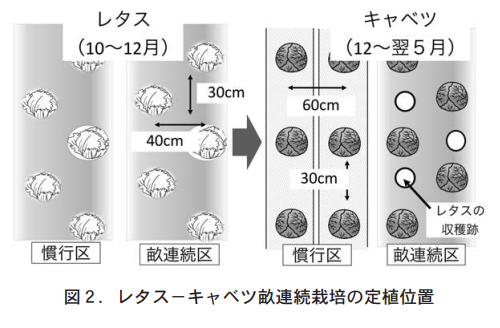
In the previous lettuce crop, 2 t of cattle manure compost was applied per 10 a, followed by base fertilization of 20 kg each per 10 a of nitrogen, phosphate, and potash. In the cabbage crop, after harvesting lettuce, the residue and mulch were removed, followed by tillage and fertilizer application in the conventional area. In the conventional area, cabbage was fertilized with 15 kg each of nitrogen, phosphate, and potash per 10 a, with a row spacing of 0.6 m and a plant spacing of 0.4 m. Celled cabbage seedlings grown in the conventional way were planted. The planting density was 5,714 plants/10a in the conventional area and 5,555 plants/10a in the continuous-row test area.
3. nitrogen fertilization in the cells to grow cabbage seedlings
In the trial in 2016 (year 1), cabbage seedlings were prepared in a special medium for seedling growth in which nitrogen was not incorporated, using coated fertilizer LPS100 and whole cell basal fertilizer. To apply the same amount of nitrogen in the cells as in the conventional method, approximately 5 g of fertilizer must be added to each cell of the seedling tray. Since the amount of soil per cell was expected to be insufficient in a standard 128-hole tray, the seedlings were grown in 72-hole cell trays. In addition, the amount of nitrogen fertilizer applied to all celled seedlings was reduced by 20% because the use of a fertilizer with regulated fertilizer (LPS100) was expected to improve the nitrogen utilization rate. No fertilizer was applied for phosphoric acid and potassium, since the amounts of their components derived from cattle manure (2 t/10a) applied before lettuce in the previous crop were estimated to be 23 kg/10a and 21 kg/10a, respectively.
In the second year of the trial, seedlings were grown in 128-hole trays using a fertilizer (24-1-0) specially designed for celled seedlings, which has a mild initial nitrogen leaching and moisture retention characteristics compared to LPS100. The amount of nitrogen fertilizer applied to the cells was reduced by 20 to 40%, and seedlings were sown on November 28 and planted on December 26. At the time of planting, the rootpots were sufficiently firm and maintained their shape. However, the seedlings were not suitable for planting with a transplanter because they were too large due to the rather long seedling growth period required for root pot formation (Photo 2). Therefore, it is necessary to study seedling growth in paper pots that can be transplanted by a transplanting machine without allowing the seedlings to grow until the root pots are completely formed.
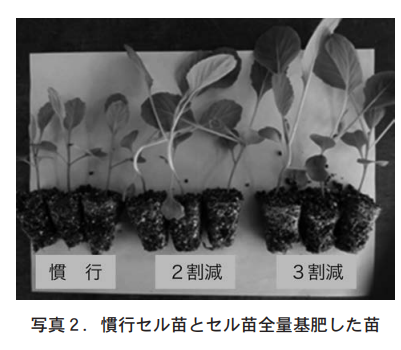
4. cabbage seedling quality and yield in the field with whole cell basal fertilizer
In the first year of the study (FY 2008), when seedlings were grown in 72-hole trays using LPS100, root pots were not sufficiently formed, and root pots collapsed during transplanting, requiring a lot of labor for planting. However, the yield of cabbage in the continuous-row area with all the cellular fertilizer was the same as that in the conventional area (Fig. 3).
In 2017 (the second year), regardless of the nitrogen fertilizer reduction rate, the weight per cabbage in the continuous-row area was heavier than in the conventional area, and the tuber yield was 1411 TP3T in the 20% fertilizer reduction area and 127-1291 TP3T in the 30% and 40% fertilizer reduction areas. The weight of a single seedling in the reduced-fertilizer zone tended to decrease as fertilizer nitrogen was reduced (Fig. 4).
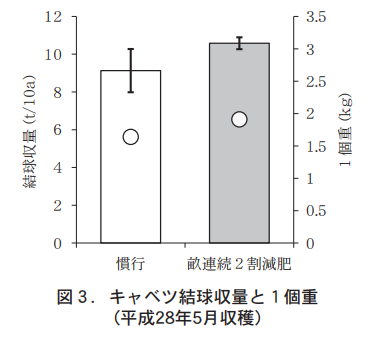
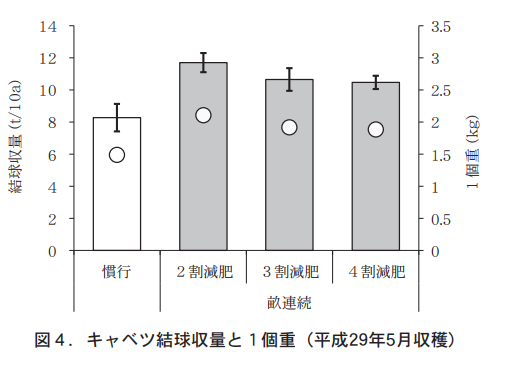
Thus, in the two-crop continuous lettuce and cabbage cultivation system, cabbage yields equal to or higher than those of conventional cultivation were secured by planting cabbage seedlings grown with cellular fertilizer without renewing the rows. This increase in yield was presumably due to the efficient use of fertilizer nitrogen in continuous row cultivation, and the fact that the black mulch kept the soil temperature high during the early stage of cabbage growth, which falls in the low temperature period, which increased the supply of soil nitrogen and promoted its growth. Based on these results, it is considered that yields equivalent to or higher than those of conventional cultivation can be obtained even when nitrogen fertilizer is reduced by 20 to 40% in continuous row cultivation.
5. nutrient balance
Table 1 shows the nutrient balance in the conventional and continuous-row areas in 2009. In the conventional plot, chemical fertilizer alone resulted in a negative balance for nitrogen and potassium and a positive balance for phosphoric acid. The nutrient balance of compost + chemical fertilizer resulted in a positive balance for nitrogen and phosphate, and a negative balance for potassium, as in the case of chemical fertilizer alone.
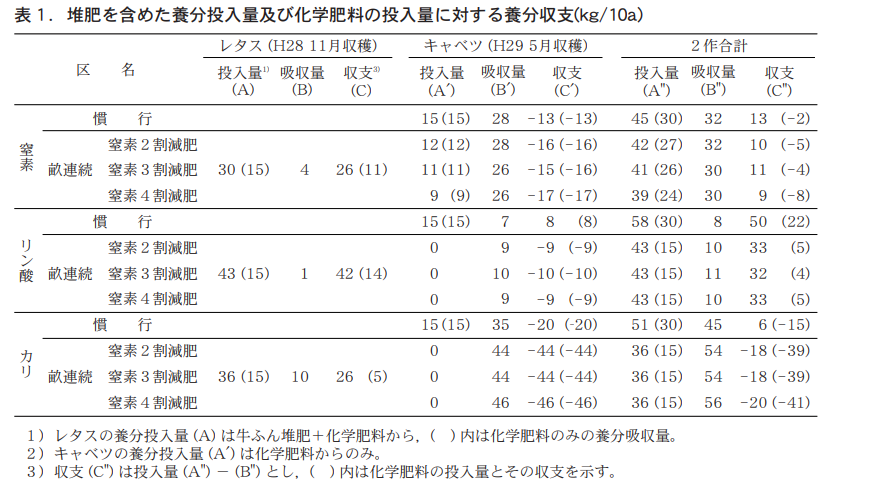
On the other hand, the nutrient balance for the two crops in the continuous-row area showed a negative balance of 4 to 8 kg nitrogen/10a when only chemical fertilizer was applied. The phosphate and potash were also in the negative balance because they were cultivated without fertilizer application. In contrast, the nutrient balance of compost + chemical fertilizer resulted in a positive balance of 9-11 kg/10a of nitrogen and 32-33 kg/10a of phosphoric acid, but a negative balance of 18-20 kg/10a of potash.
These results suggest that continuous application of cow manure compost as well as enhancement of potash fertility in the cultivated field is necessary in a system in which cabbage is cultivated in rows continuously using whole cell seedling basal fertilizer after lettuce cropping.
6. at the end
These results indicate that, as one of the technologies to realize labor-saving and low-cost large-scale open-air vegetable production, the combination of continuous row cultivation with total basal fertilizer for cell seedlings and two applications of phosphoric acid and potassium once per crop can produce higher yields than conventional cultivation even when nitrogen fertilization is reduced compared to conventional cultivation. However, if the seedlings are allowed to grow until a sufficient root pot is formed for transplanting by machine, the stems and leaves may grow too long, which may interfere with transplanting by machine. In order for agricultural corporations to use the whole cell seedling base fertilizer technology, it is important to produce seedlings of a size suitable for machine transplanting, and it is necessary to further improve productivity through better coordination with the cultivation and machinery departments.
In addition, the total basal fertilizer system for cell seedlings studied here uses a fertilizer with a regulated fertilizer effect, so nitrogen elution tends to be unstable during periods of low soil temperature. However, if the seedling growth and planting time differ significantly from the conditions described in this paper, the nitrogen release of the fertilizer may become unstable and affect the growth of the seedlings.